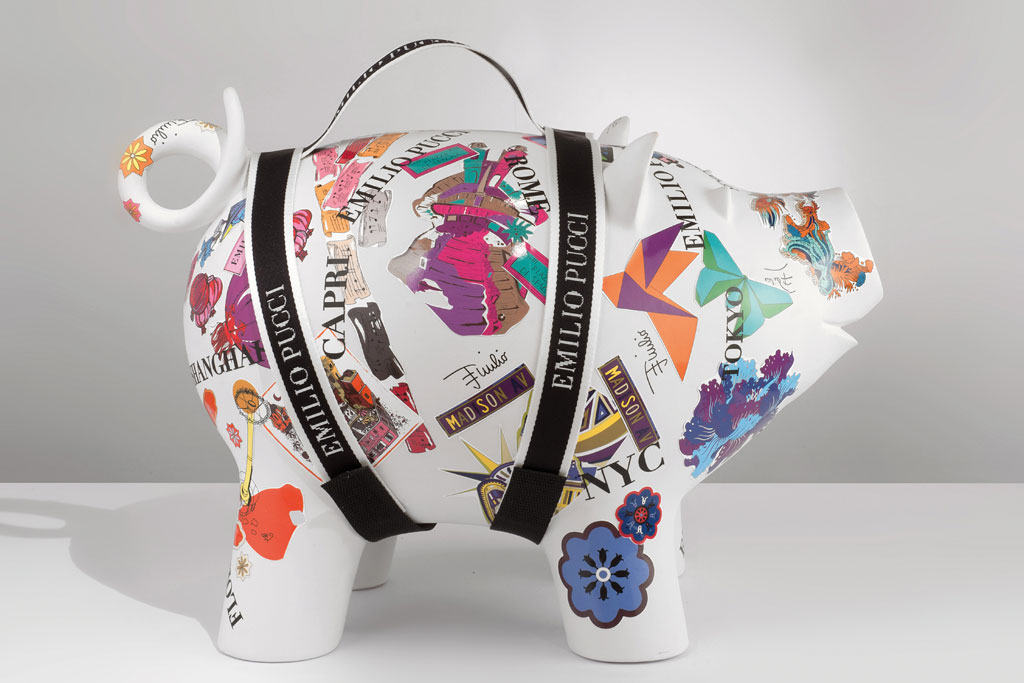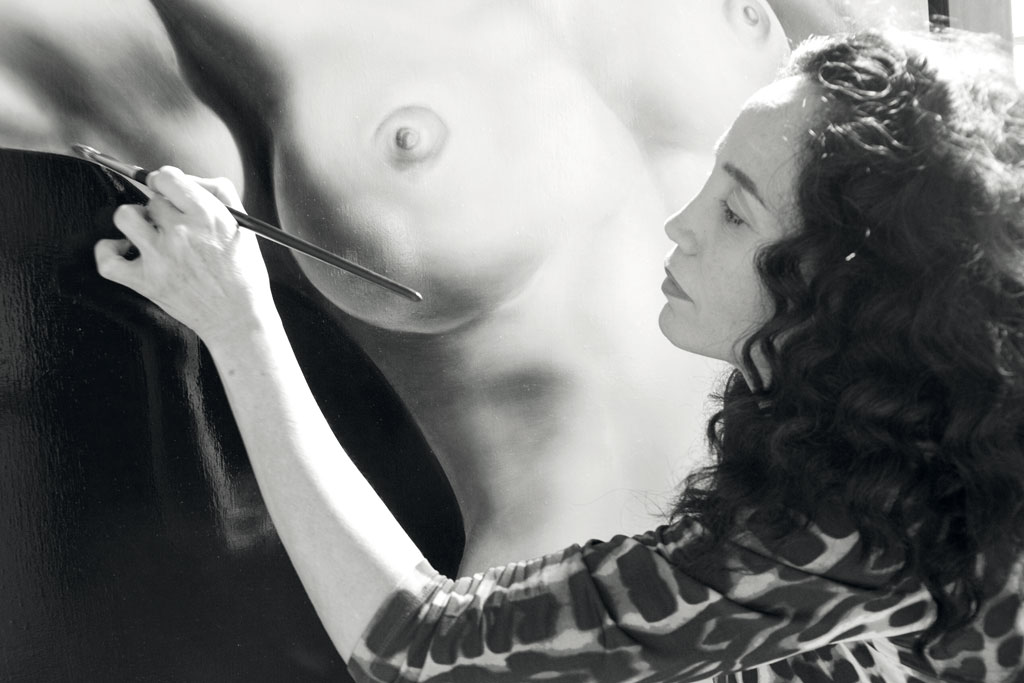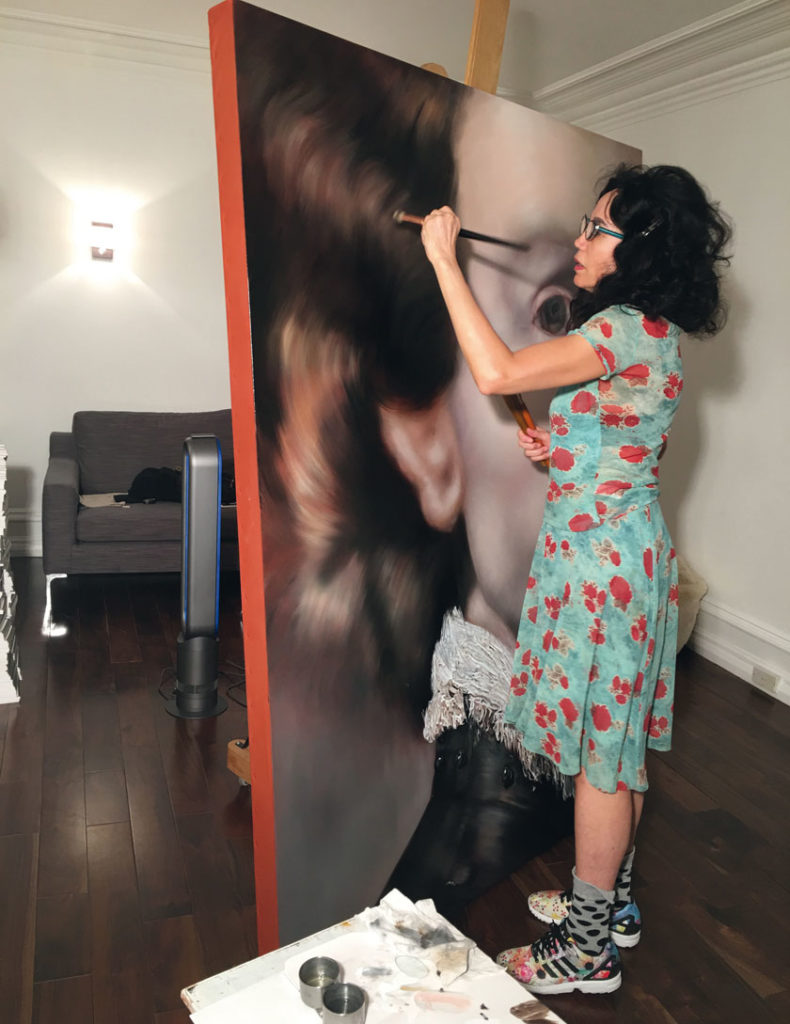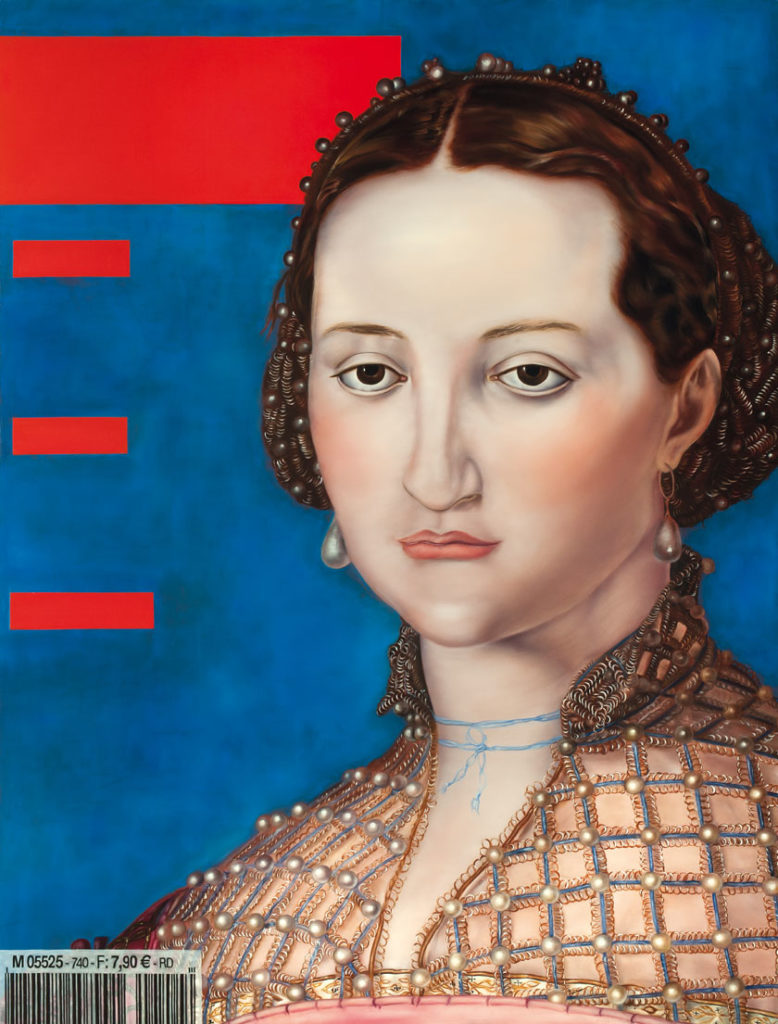Mouna Rebeiz’s New Exhibition Puts a Spin on Trash
Can trash be chic?
This post may contain affiliate links. Learn more
Beauty defiled is nothing new but French Lebanese artist Mouna Rebeiz examines it in a modern-day context in her new exhibition, says Holly Black.

Mouna Rebeiz waves frantically, as she climbs from her car and attempts to dodge the mid- morning traffic, while brandishing an oversized piggy bank. The artist cuts a glamorous figure, with wild, curly black hair, a huge grin and statuesque proportions – even in off-duty pool slides. ‘It’s Pucci!’ she exclaims, as she greets me with a continental double air-kiss and gestures at the pig, which has been decorated with the designer’s logo and fitted with a bespoke strap.
The Piggy
‘I wanted to bring one to show you,’ she explains as we enter her townhouse studio, just off the King’s Road. This is one of several ceramic piggy banks cast in Nove di Bassano, Italy, to be customised by famous designers including Giles Deacon, Lulu Guinness and Elie Saab and auctioned off in aid of the Innocence in Danger charity, which supports minors who are at risk of sexual abuse. ‘I have been supporting Homayra [Sellier] with her charity for 15 years,’ says Rebeiz, ‘and it was something of a coincidence when she said she was looking to expand in the UK, as I was moving here, so I said, “Let’s build something together”.’ True to her word, the artist used her influence across fashion, design and the visual arts to mount the charity’s first London auction, at her show in 2015. Now, she is revisiting the format at The Trash-ic, her latest exhibition at the Saatchi Gallery. Most of the bidding will take place online, but a select few pigs will be auctioned off by Sotheby’s on the opening night.

The Studio
As for the art itself, the studio is fit to burst. In the front room, there is an enormous work-in -progress panel that will be covered in pieces of primary-coloured plastic. At present this source material remains as a series of rubbish bins, ready to be dismantled. Rebeiz explains that this unfinished work is a full-circle exploration of trash as a ‘chic’ concept. ‘This vase is made from epoxy,’ she adds, as she points to a resin form displayed in the corner of the room. ‘I bought it from a very big designer, for £3,000-£4,000. A long time ago you would pay this amount for Baccarat, for crystal. But things are always changing and evolving. Who could have said that plastic could sell for £100,000? Nowadays it is not about the material, it is about the creation.’
12 of the Best Current Art Exhibitons on in London
This notion of throwaway materials being reconstituted as works of art forms the basis for the new exhibition, which is further inspired by the cyclical nature of fashion, communication and even ethical concerns in contemporary society. ‘Just look at Balenciaga,’ she continues, ‘they made bags that look like plastic, the kind you use to get your groceries. Whereas McDonalds has made their luxury series of hamburgers. I saw their advert and I thought it was for perfume! We are moving around, from trash into beauty.’

Her Assigments
As Rebeiz leads me through a corridor precariously stacked with canvases, she explains her classic training, littering her speech with the common aside ‘comment dit ça?’ (she is Lebanese, but educated mainly in France) and alluding to Renaissance techniques such as Verdaccio and Sfumato. Her steadfast knowledge and practical application was honed under the teachings of Alix de Source, a 17th and 18th-century painting specialist, who encouraged her to copy masterpieces at the Louvre. She was also compelled to travel further afield, to perfect her life drawing: ‘In France, you have life models, but it’s in small studios. The Royal Academy is outstanding. Before I lived here I would come every Tuesday from Paris, to draw.’ This unorthodox commute also meant setting up a London studio, although she still maintains another space across the Channel. Rebeiz’s roots within the Parisian art scene also run deep, as proved by her recent commission to reinterpret the cover of Connaissance des Arts magazine, which featured a self-portrait of Rembrandt.
‘They asked me to respect the painting’s composition, but to twist the cover. So, I used spray paint to change the text, to read “chaos”.’
The assignment was born out of another post-modern interpretation of a former front cover, featuring Bronzino’s Portrait of Eleanor of Toledo. She faithfully reproduced the format, but with all of the text removed. ‘It took me a week to do the barcode. It was horrible because it went over the clothes and jewellery and my heart was broken.’
The C&TH Guide to the Biggest Exhibitions of 2018

Mé connaissance des arts Ou (mon Eléonore)
Her Practice
Given the artist’s formal training, it is no surprise that the influence of historical masters plays an important part in her practice, but she also looks to more contemporary figures. Other paintings from the Trash-ic series allude to famous works by Lucien Freud, Damien Hirst, Jeff Koons and Sarah Lucas. The latter has manifested itself in a playful reimagining of Lucas’ presentation at the Venice Biennale in 2015, where she positioned women’s lower torsos on banal pieces of furniture, with cigarettes placed in various orifices. In Rebeiz’s two-dimensional version, she has painted three female figures with their backs turned, with a pipe, cigar and joint replacing the cigarettes. ‘It’s not really hashish!’ she assures me.
‘If I were in certain parts of the States I would do it [because it is legal], because I think it would be funny. Here, Saatchi would sue me!’

All joking aside, the artist is not afraid of a bit of controversy. Her version of Gustave Courbet’s The Origin of the World features a distinctly millennial female figure; skinny, devoid of body hair and alarmingly disembodied ‘as if she has been butchered’. Another, larger work also focuses on female genitalia, which have been stitched up using black ribbon. According to Rebeiz, ‘It is a metaphor, like a symbol. We are heading towards a new form of humanity that is not really ours if we make babies in labs and if women do not procreate in the belly. Also, when women are not the master of their own bodies, they are dehumanised.’ One final, abstract work that is comprised of broad gestural brushstrokes in bloody red appears to be a further exercise in violence, but the artist takes another view. ‘It is actually a very optimistic piece. After chaos you always have rebirth and I thought about giving birth to my daughter as I was painting. Everything is done with blood and effort and pain. When you are making art, you are also making a delivery – you are giving birth to something.’
The Trash-ic or Trash in the Face of Beauty at the Saatchi Gallery runs from 31 May to 7 June.
To view the silent auction, visit trashicauction.co.uk
Want to Know What Else is on in London? Our Culture Diary has you Covered
